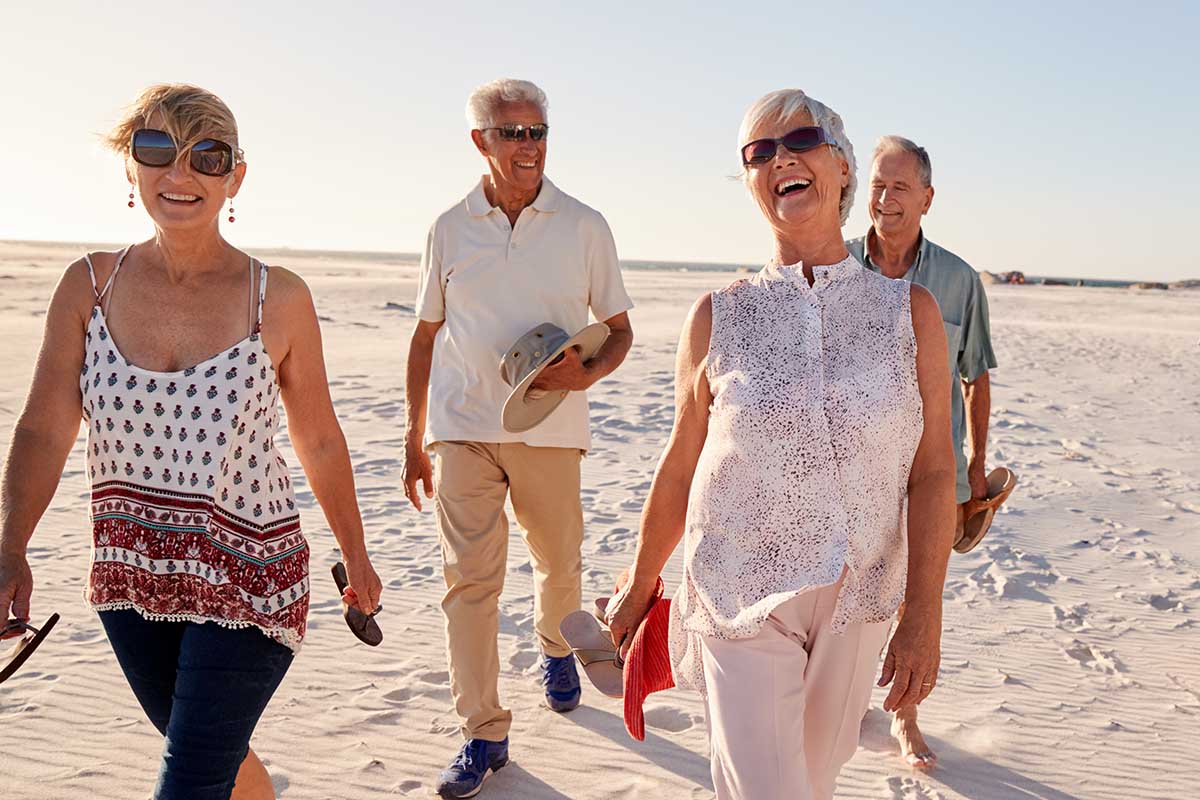Senior Citizen Trips Ideas: Planning a memorable and enriching travel experience for senior citizens requires careful consideration of various factors, from choosing the right destination and accommodations to ensuring accessibility and addressing potential health concerns. This guide explores a range of options, from domestic escapes to international adventures, offering practical advice and inspiration for crafting the perfect senior citizen getaway. We’ll delve into diverse trip types, budgeting strategies, and essential planning steps to make your journey enjoyable and stress-free.
Whether you envision a relaxing beach vacation, a culturally immersive tour, or an adventurous exploration of national parks, we’ll provide the tools and insights to help you design a trip tailored to the specific needs and preferences of senior travelers. From accessible accommodations and transportation to managing health concerns, we’ll cover all aspects of planning a safe and rewarding travel experience.
Types of Trips and Activities
Choosing the right type of trip is crucial for a fulfilling and enjoyable senior travel experience. Consider the interests and physical capabilities of the travelers when making your selection. A well-planned trip caters to specific needs and preferences, ensuring everyone has a memorable time.
Different travel styles cater to various preferences and physical capabilities. Understanding these variations allows for better trip planning and ensures a more enjoyable experience for all participants.
Five Diverse Senior Citizen Trip Types
Here are five distinct trip types, each offering unique activities and experiences tailored to the senior traveler:
- Adventure Trips: These trips focus on engaging activities that stimulate both mind and body. Examples include scenic hiking trails with manageable inclines, gentle kayaking excursions on calm waters, or wildlife viewing tours in accessible locations. The emphasis is on moderate physical activity combined with breathtaking scenery and unique experiences.
- Relaxation Trips: These trips prioritize rest and rejuvenation. Think spa retreats with massages and hydrotherapy, leisurely cruises with onboard amenities, or quiet stays at serene resorts with stunning views. The goal is to unwind, de-stress, and improve overall well-being.
- Cultural Immersion Trips: These trips delve into the history, art, and traditions of a specific region or country. Activities might include visiting historical sites, attending cultural performances, taking cooking classes featuring local cuisine, or exploring museums and art galleries. The focus is on enriching experiences and expanding knowledge.
- Wellness Retreats: These trips combine physical activity, mindfulness practices, and healthy eating to promote physical and mental well-being. Activities typically include yoga, meditation, tai chi, healthy cooking classes, and nature walks. The emphasis is on holistic health and rejuvenation.
- Coastal Getaways: These trips offer a blend of relaxation and exploration, centered around the coast. Activities include leisurely strolls along the beach, boat trips, seafood dining, and visits to charming coastal towns. The emphasis is on enjoying the seaside atmosphere and the tranquility of the ocean.
Sample Wellness Retreat Itinerary
This itinerary outlines a week-long wellness retreat designed to promote relaxation and rejuvenation for seniors. It incorporates a balance of physical activity, mindfulness practices, and healthy nutrition.
| Day | Morning | Afternoon | Evening |
|---|---|---|---|
| Monday | Gentle Yoga & Stretching | Guided Nature Walk | Meditation & Healthy Dinner |
| Tuesday | Tai Chi | Healthy Cooking Class | Relaxation Techniques & Light Snack |
| Wednesday | Meditation & Mindfulness | Free Time/Spa Treatments | Sound Bath & Herbal Tea |
| Thursday | Gentle Water Aerobics | Group Discussion/Wellness Workshop | Healthy Dinner & Movie Night |
| Friday | Yoga Nidra | Massage Therapy | Farewell Dinner & Reflection |
| Saturday | Morning Hike | Free Time/Shopping | Relaxation & Departure Preparations |
| Sunday | Departure |
Planning a Multi-Generational Family Trip
Successfully planning a multi-generational family trip requires careful consideration of everyone’s needs and preferences. Balancing the desires of seniors with the energy levels of younger family members is key to a successful and enjoyable experience for all.
For example, a trip to a national park could incorporate easier, shorter trails for seniors while offering more challenging hikes for younger family members. Evening activities could include family games or storytelling around a campfire, suitable for all ages. Choosing accommodation with accessible rooms for seniors is also crucial. Building in downtime and individual activity options allows everyone to participate at their own pace and enjoy the trip according to their preferences. This approach ensures everyone feels included and accommodated, leading to a memorable and enjoyable family vacation.
Planning and Budgeting for Senior Trips
Planning a memorable and stress-free trip for senior citizens requires careful consideration of various factors, from destination selection to budgeting and insurance. Thorough preparation ensures a smooth and enjoyable travel experience, maximizing the benefits and minimizing potential challenges. This section details the key steps involved in planning a senior-friendly trip and provides a practical budgeting example.
Choosing a Destination and Trip Duration
Selecting the right destination is crucial. Consider factors such as accessibility, climate, activities of interest, and the overall pace of the trip. Destinations with good healthcare access are also important. A shorter trip duration, such as a week, might be preferable for first-time senior travelers or those with limited mobility, while longer trips are suitable for more experienced travelers. Consider the interests of the travelers; a relaxing beach vacation might suit some, while others might prefer a culturally rich city break.
Booking Flights and Accommodations
Once the destination is chosen, booking flights and accommodations is the next step. Consider booking flights well in advance, especially during peak seasons, to secure better deals and preferred flight times. For accommodations, explore senior-friendly options such as hotels with accessible rooms, elevators, and on-site amenities. Consider booking accommodations with a good safety record and 24-hour assistance. Reading reviews from other senior travelers can be particularly helpful.
Planning Activities and Excursions
The activities chosen should be tailored to the physical capabilities and interests of the senior travelers. Opt for activities that are not overly strenuous and allow for rest periods. Consider booking tours and excursions in advance, especially popular ones, to avoid disappointment. Research accessibility features at attractions to ensure everyone can participate comfortably. Pre-booking transportation within the destination is also recommended.
Sample Budget for a Seven-Day Trip to Sedona, Arizona
This budget example is for a seven-day trip to Sedona, Arizona, known for its stunning red rock formations and mild weather, suitable for many seniors. Prices are estimates and can vary depending on the time of year and specific choices.
| Item | Estimated Cost |
|---|---|
| Flights (round trip) | $500 – $800 |
| Accommodation (7 nights) | $700 – $1400 (mid-range hotel) |
| Activities & Excursions (e.g., Pink Jeep Tours, hiking) | $300 – $500 |
| Food (7 days) | $350 – $700 (mix of dining out and groceries) |
| Transportation (local) | $100 – $200 (rental car or taxis) |
| Miscellaneous (souvenirs, tips) | $100 – $200 |
| Total Estimated Cost | $2050 – $3800 |
Travel Insurance for Senior Citizens
Travel insurance is crucial for senior citizens, providing financial protection against unforeseen circumstances such as medical emergencies, trip cancellations, and lost luggage. Several types of coverage exist:
- Comprehensive Travel Insurance: This covers a wide range of scenarios, including medical emergencies, trip cancellations due to illness, lost luggage, and flight delays.
- Medical Emergency Insurance: This specifically covers medical expenses incurred during the trip, including hospitalization and evacuation.
- Trip Cancellation Insurance: This covers the cost of canceling the trip due to unforeseen circumstances, such as illness or family emergencies.
It is advisable to carefully review the policy details and choose a plan that meets the specific needs and concerns of the senior traveler. Consider pre-existing conditions when selecting a policy. Some policies may have exclusions for certain medical conditions.
Accessibility and Health Considerations
Planning a senior citizen trip requires careful consideration of accessibility and health factors to ensure a safe and enjoyable experience for all participants. Overlooking these crucial aspects can significantly impact the overall trip satisfaction and even pose potential health risks. This section focuses on practical strategies to mitigate these concerns and create a more inclusive and comfortable travel experience.
Accessibility Needs
Accessibility is paramount when planning trips for senior citizens. This involves ensuring easy navigation for individuals with varying mobility levels. Wheelchair access, including ramps, accessible restrooms, and wide doorways, should be confirmed at all locations, including hotels, transportation hubs, and attractions. Similarly, the availability of assistive devices, such as walkers and mobility scooters, should be considered, along with the feasibility of using them in the planned locations. Pre-trip research into the accessibility features of chosen destinations is crucial, and contacting venues directly to confirm accessibility details is highly recommended. Consider also the availability of accessible transportation options, such as wheelchair-accessible taxis or buses.
Packing Essentials for Health and Comfort
Proper packing is vital for a comfortable and safe trip. Senior citizens should prioritize packing items that address their specific health needs and enhance their comfort during travel.
- Medications: Pack an ample supply of all prescription and over-the-counter medications, including a copy of prescriptions. Consider carrying a small, portable first-aid kit with bandages, antiseptic wipes, pain relievers, and any other personal medical supplies.
- Comfortable Clothing and Footwear: Loose-fitting, comfortable clothing made from breathable fabrics is recommended. Supportive and comfortable footwear is essential to prevent falls and blisters. Consider packing layers to adjust to changing temperatures.
- Mobility Aids: If using a walker, cane, or wheelchair, ensure it’s packed securely and readily accessible. Spare parts or repair kits should be included, if applicable.
- Personal Care Items: Include any necessary personal care items, such as toiletries, sunscreen, insect repellent, and any specialized skincare products.
- Emergency Contact Information: Carry a list of emergency contacts, including family members, doctors, and local emergency services, readily accessible.
Managing Potential Health Concerns During Travel
Travel can present unique challenges for individuals with pre-existing health conditions. Proactive planning is key to mitigating potential issues.
Medication management is crucial. Carry medications in their original containers with labels clearly visible. Pack enough medication for the entire trip, plus a few extra days’ worth in case of delays. Consult with a physician regarding any potential medication adjustments needed due to travel or changes in time zones. It is also advisable to carry a copy of your medical history and a list of allergies, along with the names and contact information of your physicians. Furthermore, researching the availability of healthcare services at your destination is vital. Identify nearby hospitals, clinics, and pharmacies, and note their contact information. Travel insurance that covers medical emergencies is highly recommended. Consider informing your family or friends of your itinerary and expected return date.
Epilogue
Ultimately, the ideal senior citizen trip hinges on careful planning and a focus on personal preferences and physical capabilities. By thoughtfully considering factors such as accessibility, health concerns, and budget, you can create a travel experience that is both memorable and enriching. This guide serves as a starting point for your planning journey, empowering you to design a trip that celebrates the joys of travel while prioritizing comfort, safety, and well-being. Remember to embrace the flexibility inherent in planning, and don’t hesitate to adjust your itinerary as needed to ensure a truly enjoyable experience.




